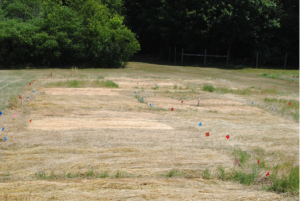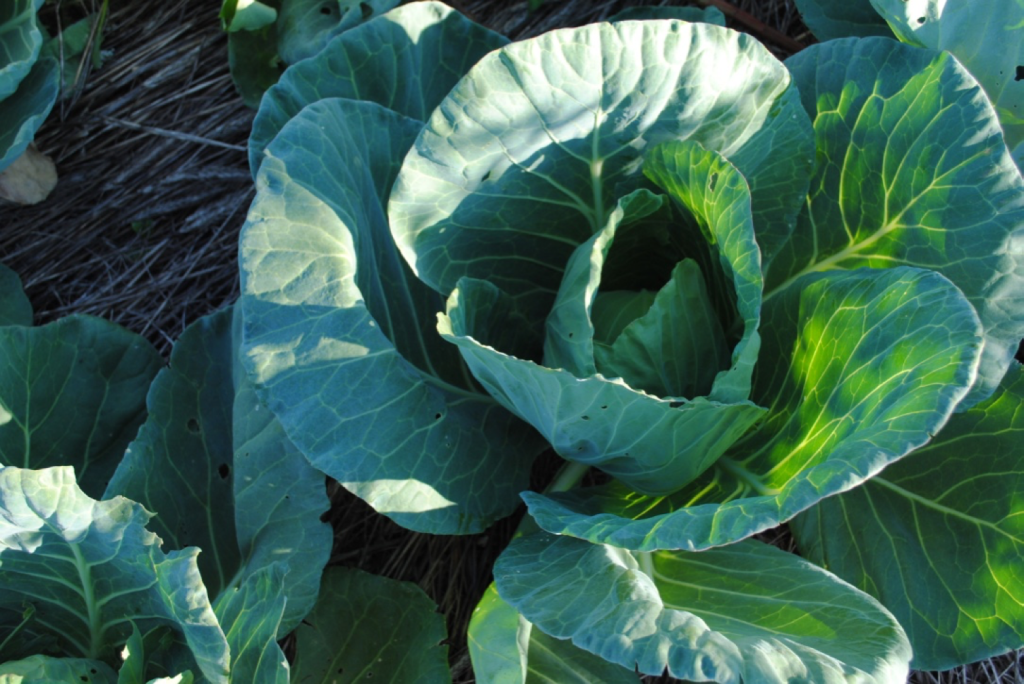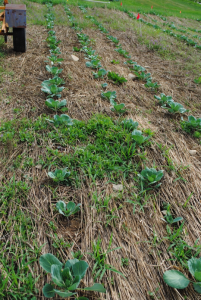
Tarps were removed on July 7 and cabbages were transplanted soon after.
When I last wrote in June, I was really excited about how quickly the clear tarps were killing cover crops and weeds. I even proclaimed “the answer is clear: solarization is outperforming occultation.” Now that the tarps have been off and the cabbage has been in the ground for over six weeks, things have changed. I wanted to give an update, even though this is still preliminary, because the differences between treatments in terms of weed suppression are now so pronounced.
The good news first: the cabbages and weed suppression are looking really good where there were black tarps.

No-till transplanted Farao (Johnny’s) cabbage in a rye-vetch mulch where weeds were suppressed using a black tarp prior to transplanting.
We don’t have data yet on cabbage yield (because they’re not finished growing), and we don’t have quantitative data on weeds, but the evidence is pretty apparent visually that the weeds are much lower where there were black tarps, not clear tarps. In fact, it almost seems that the clear tarps may have stimulated certain weeds like crabgrass- ack!! Under optimal conditions, solarization is supposed to cook crabgrass weed seeds, but we may not have attained optimal conditions for a few reasons:
- We didn’t water the soil before applying the clear plastic, and it was rather dry on some of the tarp application dates.
- We are in New Hampshire, not California- it may not have gotten hot enough.
- The cover crop mulch in between the soil and plastic may have interfered with the weed seed killing in some way; previous experimentation with solarization has been with bare soil.

Differences between tarp treatments were apparent three weeks after transplanting: foreground is the clear tarp, middle is the black tarp, and background is no tarp.
You live, you learn. Next time we will create optimal conditions as best we can for solarization so we give it a fair shot.
There is also the possibility that the residue decomposed more quickly under the clear tarps, leaving less mulch to suppress weeds. We are compiling the data on that and will report results soon.
The weed suppression where the black tarps were has been phenomenal considering it wasn’t a super high biomass cover crop. Other than some buckwheat volunteers, there are very few weeds more than six weeks after transplanting. This is in line with that researchers at the University of Maryland observed when they used landscape cloth for a couple of weeks over a rye-vetch mulch. At this point , weeds in the cabbage will have little effect because they are beyond the critical weed free period . However, as any farmer knows, weeds in the field are not important just for the current crop, but for contributions they may make to the weed seed bank if they go to seed. It doesn’t appear that the few weeds emerging in the black tarp treatments will go to seed, but the crabgrass and other weeds in the clear tarp treatments have already started to (apologies to future researchers who will be using that field!).

Seamus in the cabbage field. It may look hectic, but there are a lot of interesting things going on with weeds in this field. Using black tarps may be a viable way to provide enough weed suppression for no-till production.
One final note on this update: This was a very dry year in New Hampshire. In the first 23 days of August, we’ve had just 1.29 inches of rain. We irrigated the cabbage immediately after transplanting in July, but haven’t irrigated since. In a dry year, having mulch on the soil is incredibly important to keep moisture in. It can keep the soil cooler, which can delay plant growth, but that is probably a good trade-off for a year like this.
We’ll harvest weeds and cabbage in September and will keep you updated.



